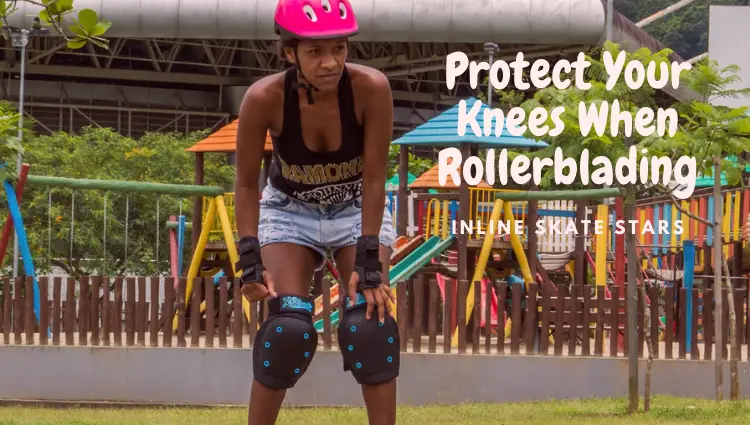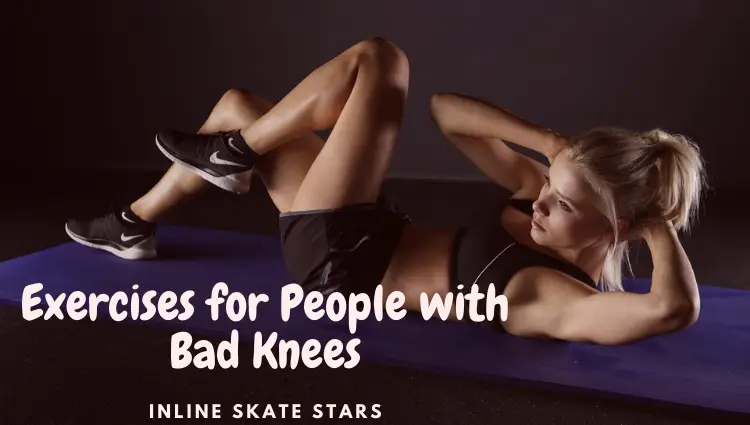Is rollerblading bad for knees? From personal experience and research, I know that rollerblading is good for knees compared to jogging, walking, or running. This is because, as an exercise, rollerblading is low impact thus safe on joints. Besides, rollerblading helps to strengthen the knees the more one skates.
So, if you have a bad knee, rest assured you can still exercise, keep fit and healthy while having fun. Guess what? All this is possible thanks to inline skating as a sport. The best part is, you can do rollerblading while also doing other forms of exercising.
If you’ve ever wondered whether rollerblading is good or bad for knees, hopefully, today, you’ll get the answer you’ve been looking for. So, without much ado, let’s quickly dive into the meaty part. Shall we?
Is Rollerblading Good for Your Knees? Is Roller Skating Good for Knees?

Getting into your rollerblades and going to a skate park or just skating in the neighborhood is fun and exciting. If you’re yet to get started, you’ve got no idea how much you’ve been missing. Skating relaxes your body, improves your overall health, and gets you in a high-spirited mood all the time.
Therefore, the fear of pain in the knees while rollerblading shouldn’t stop you from taking part in this exciting adventure. I feel obligated to challenge the idea of rollerblading being bad for knees. And in my skating experience, I’ve never felt knee pain.
So, is rollerblading bad for knees? Absolutely no! Below are the reasons I give to help you see the bigger picture. Let’s have fun!
1. Inline Skating is low Impact Aerobic Exercise thus safe on Joints
There are tons of health benefits from rollerblading and low-impact aerobic exercise standards out for me. What does low impact mean? You could be wondering.
According to research, ‘Low-Impact Aerobic Exercise,’ by Spine Health, low impact means low pressure on the joints, making it safe and less painful for people with bad knees and joint pains. So, how does this low-impact aerobics ‘thing’ work? You’re probably asking.
A low-impact aerobic exercise helps to relieve pain by minimizing stiffness around joints and muscles. Besides, it helps improve blood flow in the body for an efficient supply of nutrients. You mean rollerblading can help with all these? YES!
Since inline skating is considered low-impact aerobic exercise, you’ll get to enjoy all these benefits. The best part is, it’s the best for people with bad knees and other joint-related pains. In my opinion and experience, it’s the best way to have fun while staying healthy.
Also, rollerblading as an aerobic exercise helps you to lose weight by burning excess calories around your body and, in particular, your knees and lower body parts. Too much weight around the knees exerts pressure on the knee joint resulting in more pain.
However, this becomes a thing of the past when you can lose excess weight, thanks to rollerblading. But that’s not all! Inline skating and aerobic exercising help with the production of endorphins.
According to Medical News Today, endorphins are chemicals produced by the body to relieve stress and pain. So, if rollerblading can help your body produce endorphins to ease the pain around your knees, why wouldn’t you give the spot a try?
When getting started in rollerblading, you want to take it one day at a time before deciding to go full blast. According to recommendations by the American Heart Association, adults need between 20 and 30 minutes of moderate daily aerobic activity.
For kids between 3 and 5 years, they need to be more active throughout the day. So, 60minutes of aerobic exercise would be suitable for a start.
While on your rollerblades, this time quickly passes before you know it, so it shouldn’t feel like a lot. The good news is, you can scale up as you deem fit and depending on your comfortable you feel.
2. Rollerblading Strengthens Knees
Rollerblading comes in handy in muscle development, especially the lower body muscles. Among the muscles rollerblading helps develop include; leg muscles, hip muscles, glute muscles, core muscles, and hand muscles.
How does this work, you ask? As you rollerblade, the muscles are actively engaged and help propel you around. In the process, the muscles develop further to provide more stamina and strength.
Guess what? Stronger muscles can help improve your skating skills, thereby keeping knee and other joint-related injuries at bay.
How to Protect your Knees when Skating

No doubt, minor accidents like falling can occur when skating. However, this shouldn’t cause fear and the reason not to indulge in rollerblading. For starters, you should always wear protective gear while skating.
A protective gear protects your body parts from injuries when you fall. For your knees, you can wear knee pads to protect your knees from knee injuries. The best knee pads are comfortable to skate in, easy to put on and offer ultimate protection around the knee area.
The best part is, some can be put inside your clothing while others can go around your knees on top of the cloth. So it boils down to what makes you feel comfortable.
Roller Skating with Bad Knees
It is generally not recommended to roller skate if you have bad knees. Roller skating can put a lot of strain on the knees, especially if you are not used to it or if you are not in good physical shape.
If you have bad knees, it is important to speak with a doctor or physical therapist before attempting any new physical activity. They can help you determine if roller skating is safe for you and provide guidance on how to minimize the risk of injury.
If you are determined to try roller skating despite having bad knees, it is important to start slowly and to pay close attention to your body’s signals.
If you experience any pain or discomfort while roller skating, stop immediately and take a break. It is also a good idea to wear protective gear, such as knee pads, to help reduce the risk of injury.
Other Exercises for People with Bad Knees

Having bad knees shouldn’t spell doom for you. You can still engage in exercise activities like everyone else. So, besides rollerblading, what else is there to try? Let’s quickly find out more forms of exercise for people with bad knees.
- Making Lunges.
- Stretching the Heels.
- Stretching the Calves.
- Quadriceps stretch.
- Hamstring stretch.
- Half squats.
- Calf raises.
- Hamstring curl.
- Leg extensions.
- Leg raises (prone, straight, and sides).
- Yoga.
- Walking.
- Swimming.
Is Rollerblading Bad for Knees: Frequently Asked Questions
1. How do I protect my knees when skating?
The best way to protect your knees when skating is by putting on reliable protective gear. The best protective gear includes knee pads that offer protection around your knees and keeps you from fall injuries.
2. Why do my knees hurt when I skate?
Your knees probably hurt because of excess body weight, which exerts pressure on your knees and can be a painful experience. However, with regular skating, this problem should go away eventually since rollerblading is low impact aerobic exercise that helps with the production of endorphins. This chemical helps relieve pressure and takes the pain away.
3. What is the best exercise for bad knees?
The best exercise for bad knees is rollerblading since it is low impact and doesn’t strain your knee joints. Besides, it’s fun to indulge in and helps keep the body relaxed, excited and improves self-confidence. Rollerblading also strengthens knee muscles and helps to keep knee injuries away.
4. What exercises can I do to lose weight with bad knees?
Typical exercises to indulge in and lose weight when having bad knees include;
- Rollerblading.
- Making Lunges.
- Stretching the Heels.
- Stretching the Calves.
- Quadriceps stretch.
- Hamstring stretch.
- Half squats.
- Calf raises.
- Hamstring curl.
- Leg extensions.
- Leg raises (prone, straight, and sides).
- Yoga.
- Walking.
- Swimming.
5. Is roller skating hard on joints?
Roller skating is soft and easy on joints since it’s considered a low-impact aerobic exercise. This means you’ll feel no pain when engaging in roller skating, even when you have bad knees.
6. Does skating strengthen the knees?
Skating works on all body muscles, especially the lower body muscles, including the legs, hips, and glutes. As you skate, the muscles around the knees are strengthened to help keep the gliding motion.
7. Is rollerblading an aerobic exercise?
Yes, rollerblading can be an aerobic exercise, as it involves sustained, rhythmic movement that increases your heart rate and can help improve your cardiovascular endurance.
Rollerblading is a low-impact activity that can be easier on your joints than other high-impact activities, such as running or jumping. It can also be a fun and enjoyable way to get some exercise and enjoy the outdoors.
To get the most benefit from rollerblading as an aerobic exercise, it is important to maintain a steady pace and try to keep your heart rate at a moderate to high level for at least 20-30 minutes.
You can also incorporate interval training, where you alternate between periods of higher and lower intensity, to increase the challenge and variety of your workouts.
As with any new physical activity, it is a good idea to start slowly and gradually increase the intensity and duration of your rollerblading sessions as you become more comfortable and confident.
8. Is rollerblading low impact?
Rollerblading is generally considered to be a low-impact activity, which means that it puts less strain on the joints compared to high-impact activities like running or jumping.
This can make rollerblading a good option for people who are looking for an effective way to get some exercise but are concerned about the impact on their joints.
However, it’s important to note that rollerblading can still involve some impact on the joints, especially if you are skating on rough or uneven surfaces or if you are not using proper technique.
To minimize the impact on your joints while rollerblading, it is important to use good form and to try to maintain a smooth, fluid motion.
It is also a good idea to wear protective gear, such as wrist guards, knee pads, and elbow pads, to help reduce the risk of injury.
As with any new physical activity, it is a good idea to start slowly and gradually increase the intensity and duration of your rollerblading sessions as you become more comfortable and confident.
Is Rollerblading Bad for Knees: Final Thoughts
Is rollerblading bad for knees? Nothing can be further from the truth. Rollerblading is good for knees compared to jogging, walking, or running. This is because, as an exercise, rollerblading is low impact thus safe on joints. Besides, rollerblading helps to strengthen the knees the more one skates.
Nevertheless, you should always wear protective gear to protect your knees during a fall. When done correctly, you can reap tons of health benefits from rollerblading. So, don’t let bad knees be the reason you’re not having fun. Start rollerblading today and watch as your knee problem fades away. Happy skating!


